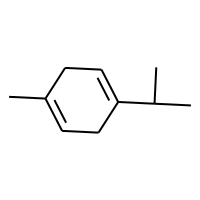
gamma-Terpinene
| Chemical identification | |
|---|---|
| Pubchem identifier | 7461 |
| CAS identifier | 99-85-4 |
| DSSTOX identifier | DTXSID6041210 |
| IUPAC name | gamma-Terpinene |
| SMILES | CC1=CCC(=CC1)C(C)C |
| InChI | InChI=1S/C10H16/c1-8(2)10-6-4-9(3)5-7-10/h4,7-8H,5-6H2,1-3H3 |
| InChIKey | YKFLAYDHMOASIY-UHFFFAOYSA-N |
| Synonyms | 1-Methyl-4-isopropylcyclohexadiene-1,4; gamma-Terpinene; 1,4-Cyclohexadiene, 1-methyl-4-isopropyl-; Crithmene; Moslene; p-Mentha-1,4-diene; TERPINENE, ALPHA; 1,4-Cyclohexadiene, 1-methyl-4-(1-methylethyl)-; 4-Isopropyl-1-methyl-1,4-cyclohexadiene; 1-Methyl-4-(1-methylethyl)-1,4-cyclohexadiene; gamma-Terpinen |
| Odor profile | |
|---|---|
| Odor classes | Aromatic, Citrus, Edible oil, Mineral, Seed spices, Sweet spices, Vegetable |
| Reference | [1] |
| Presence in Children's products | |
|---|---|
| Broad category | Miscellaneous |
| Subcategory | General Baby products |
| Chemical classification based on ClassyFire | |
|---|---|
| Chemical kingdom | Organic compounds |
| Chemical super-class | Hydrocarbons |
| Chemical class | Unsaturated hydrocarbons |
| Chemical subclass | Branched unsaturated hydrocarbons |
| Natural source for the chemical | |||
|---|---|---|---|
| Organism | Kingdom | Genus | Family |
| Acorus calanus L. | Plantae | Acorus | Acoraceae |
| Allium sativum | Plantae | Allium | Alliaceae |
| Mangifera indica | Plantae | Mangifera | Anacardiaceae |
| Thymus pubescens | Plantae | Thymus | Lamiaceae |
| Carum carvi | Plantae | Carum | Apiaceae |
| Reference | [1], [2], [3], [4], [5] | ||